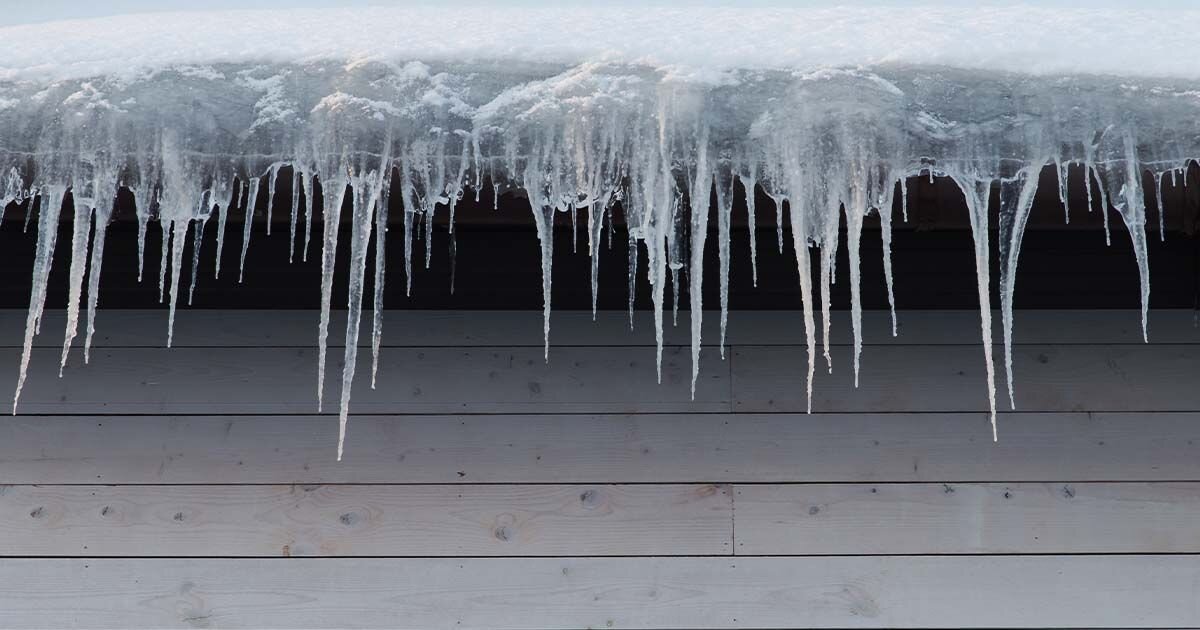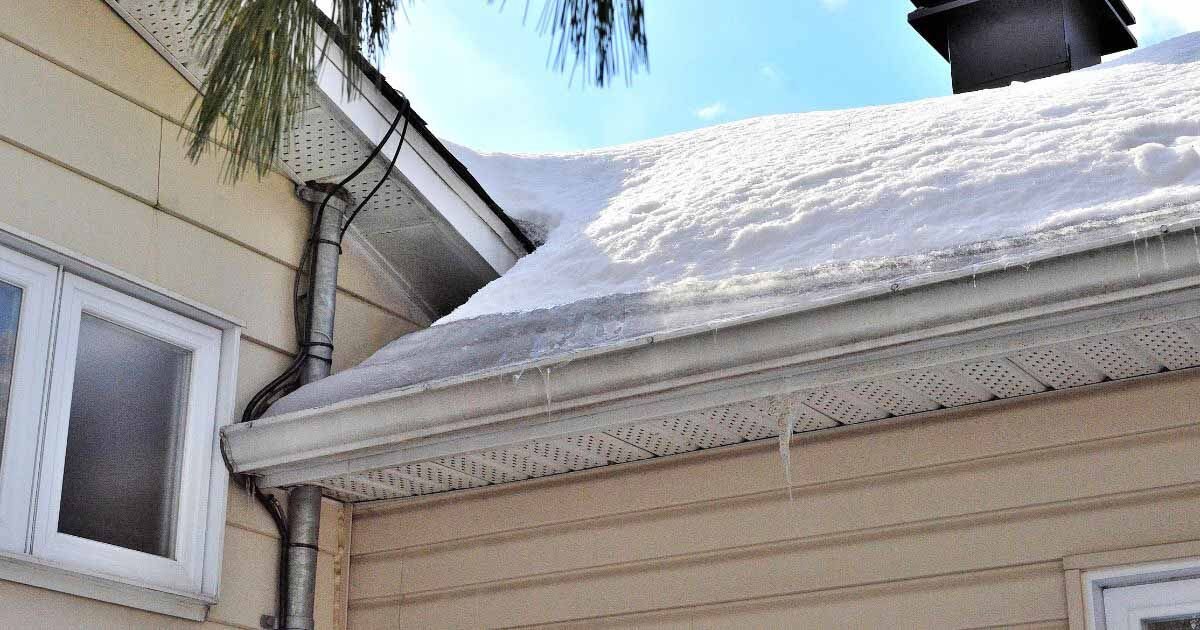
Every winter, homeowners prepare to face challenging weather conditions that create inconvenient and potentially dangerous outcomes, such as ice dams. These are thick ridges of solid ice that build up along the edges of roofs, forming icicles. The problem with ice dams is that they can pose a significant risk to your home, potentially causing damage. An ice dam can force water under your roofing shingles, where it can drip into insulation and walls, causing mold and rot.
Understanding how ice dams are formed and what you can do to prevent it is an effective way to protect your property during these freezing-cold Canadian months. In this blog, we’ll explore the science behind ice dams, the dangers they can cause to your home, and both immediate and long-term strategies to prevent recurrence. We’ll also discuss when and why it’s wise to call in our experts from Rick MacDonald Siding, Roofing, Windows & Doors to handle these winter challenges.
What are Ice Dams?
An ice dam is a ridge of ice that forms at the edge of a roof and traps melting snow behind it, preventing it from draining off the roof as it should. This might not sound like a problem to the average homeowner initially, but harsh weather conditions can make these issues more apparent, leading to unexpected, severe problems for your home.
Ice dams typically occur after a heavy snowfall when the upper areas of a roof, usually those directly above an attic, become warm enough to melt the snow that has accumulated there. This melting snow then trickles down toward the eaves, which are colder because they extend beyond the side of the house and have no attic space between them to keep them warm.
Once the water reaches the eaves, its temperature freezes, gradually building up a wall of ice. This cycle repeats each day that conditions allow, with the dam growing more extensive and the area of trapped water increasing. Several factors contribute to uneven temperature, causing the formation of ice dams:
- Heat Loss from the House: Poor insulation and air leaks in the attic allow heat to escape, warming parts of the roof.
- Sun Exposure: Parts of the roof that receive direct sunlight will be warmer.
- External Temperatures: The outside air temperature also plays a role, as it needs to be cold enough to keep the eaves below freezing.
Understanding how ice dams are made is the first step to preventing potential damage to your home. Rick MacDonald Siding, Roofing, Windows, and Doors can help evaluate and address these issues, ensuring a safe, secure, and energy-efficient home.

The Dangers of Ice Dams
Ice Dams may seem minor, but if left unaddressed, they can cause substantial damage to your home and health. Awareness of these risks can help you appreciate the importance of proactive measures to prevent their formation.
- Home Damage: Ice dams can wreak havoc on your home in several ways
- Leaks and Water Damage: When ice dams block the natural flow of melted snow off your roof, water pools behind the dam. This water can seep under shingles and into your home, leading to leaks that may not be immediately noticeable. Over time, these leaks can cause irreversible damage to your home's ceilings, walls, insulation, and even structural integrity.
- Damaged Gutters and Roof: The weight of the ice itself can strain gutters and roofing materials. In severe cases, gutters can detach from the house, and shingles may be lifted or broken, exposing the roof to further damage.
- Health Risks: The consequences of ice dams extend beyond structural damage, posing several health risks:
- Mold and Mildew: Moisture entering the home from ice dams creates an ideal environment for mold and mildew to thrive. These fungi can spread rapidly within walls and ceilings, often going undetected until they cause visible damage or odours.
- Black Mold: Particularly concerning is black mold, which can develop in persistently moist areas. Exposure to black mold is known to cause severe health problems, including chronic coughing, sneezing, eye and skin irritation, and even long-term respiratory conditions.
- Respiratory Issues: Mold and mildew are more than just structural concerns; they can seriously impact indoor air quality. Exposure to mold spores has been linked to various respiratory problems, from allergic reactions to asthma attacks, particularly in children, the elderly, animals, and those with pre-existing respiratory conditions.
To protect your home and health from the dangers of ice dams, preventing their formation and promptly addressing any existing issues is essential. To ensure appropriate measures are taken to secure your property, Rick MacDonald Siding, Roofing, Windows & Doors can help protect against these environmental challenges.
Immediate Solutions to Combat Ice Dams
When ice dams form, quick action can minimize damage until more permanent solutions can be implemented. Here are some immediate steps you can take to combat these icy build-ups effectively and safely:
Short-term Remedies
- Use a Roof Rake: This tool allows you to remove snow from the roof without climbing onto it. Carefully pull down the snow from the roof's edge to prevent ice dams from forming. Be sure to stand clear of the falling snow to avoid injury.
- Hosing with Tap Water: On a warm day, gently hose down the roof with tap water to melt through the ice dam, creating a channel for the trapped water to escape. This temporary method should only be used when temperatures are sufficiently above freezing to prevent further ice formation.
- Create Channels in the Ice: If water is already backing up behind an ice dam, carefully create channels through the ice to facilitate drainage. This should be done cautiously to avoid damaging the roofing materials.
Safety Tips
- Avoid Physical Damage: Never use sharp tools like axes or hammers to break ice on the roof, as these can tear through shingles and roofing materials.
- Use Proper Equipment: When using a roof rake or hosing down the roof, make sure you have the proper safety gear, such as gloves and eye protection.
- Stay Grounded: Always perform these actions from the ground or a stable platform rather than climbing on the roof, which is extremely slippery due to ice and snow.
Following these steps can quickly alleviate ice dams. However, these are temporary fixes, so addressing underlying issues is essential for long-term prevention. Consulting with Rick MacDonald Siding, Roofing, Windows & Doors can help you develop a comprehensive protection plan.
Long-term Prevention Strategies
Addressing the fundamental causes of your home’s insulation and ventilation is the first step to effectively preventing ice dams over the long term. Here’s how you can manage these aspects for a more permanent solution:
- Insulation and Ventilation: Insulation and ventilation in your attic are a vital part of preventing ice dams:
- Increased Insulation: Upgrading your attic insulation helps maintain a uniform temperature across your roof, preventing the warm spots that cause snow to melt and freeze at the eaves.
- Proper Ventilation: Adequate ventilation helps the attic temperature stay the same as the outside air, preventing uneven snow from melting on the roof. It’s important to check that insulation or other materials do not obstruct vents, allowing good airflow.
- Professional Solutions: Consulting with our roofing experts can lead to solutions that fit your home’s specific needs.
- Roof Evaluation: Our professionals can perform a detailed assessment of your roof to identify areas where heat is escaping and suggest the best improvements.
- Installing Heating Cables: For homes prone to ice dams, installing heating cables along the roof’s edges can prevent ice from forming by keeping the eaves sufficiently warm.
Taking these steps not only avoids the formation of ice dams but also aids in your home's energy efficiency. Our professionals at Rick MacDonald Siding, Roofing, Windows & Doors can ensure that all interventions are currently installed and maintained for maximum protection against ice dam hazards.
Expert Solutions: Why Professional Help is Better
When it comes to managing and preventing ice dams, professional help can be invaluable. Here’s why getting expert advice and services from Rick MacDonald is a wise decision:
- Professional Assessment: Using specialized tools and in-depth knowledge, our roofing professionals can detect subtle issues, such as improper insulation or poor attic ventilation, that might not be obvious to most homeowners.
- Customized Solution: Every home is unique, and factors such as roof slope and architectural design can affect ice dam formation. Professionals provide customized solutions that specifically cater to your home's architectural features.
- Cost Efficiency: Investing in professional help can save money in the long run. By preventing ice dams effectively, you avoid the extensive damage they can cause, from water leakage to structural repairs–costs that can quickly add up if not managed properly.
- Safety: Removing ice dams can be dangerous work, especially without proper equipment or experience. Professionals eliminate this risk by doing the job safely and efficiently, preventing damage during ice dam removal.
Understanding and addressing ice dam prevention requires both immediate actions and long-term solutions. Protect your home by increasing insulation, improving ventilation, and considering a professional assessment to prevent costly damage. For export help and tailored solutions that protect your home’s safety and integrity, contact Rick MacDonald Siding, Roofing, Windows & Doors today.
